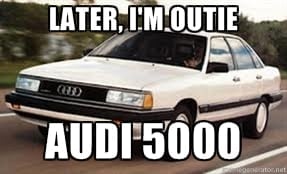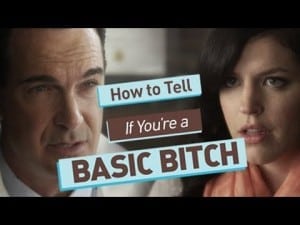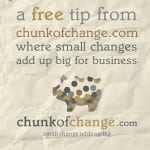As someone who writes and speaks about the supreme importance of standing out by having a clear unique value proposition (UVP) that hits the right target market, I was shocked to learn last week that I was way off base and, to make matters worse, with one of my own clients.
It’s not at all easy for me to write about these kinds of lessons / failures / shortcomings / flaws, but:
(a) I’m learning to embrace vulnerability and
(b) I truly want to help my small business owner readers…even if it means I have to reveal that I’m not always perfect. Actually, not even close.
 So, here goes. Last week, during the course of my day job (as owner of a design firm), I got a call from a long-term client, who announced that she would be “moving on.” It was a shock; she had always been pleased with what we’d delivered and had never complained about a thing. But, by the same token, she had also never responded to my email check-ins, nor taken advantage of the quarterly strategy sessions included with her contract.
So, here goes. Last week, during the course of my day job (as owner of a design firm), I got a call from a long-term client, who announced that she would be “moving on.” It was a shock; she had always been pleased with what we’d delivered and had never complained about a thing. But, by the same token, she had also never responded to my email check-ins, nor taken advantage of the quarterly strategy sessions included with her contract.
In short, what she was getting (web design from years ago, current web hosting, and updates) and what she was paying for (marketing strategy, creative communication that evolves with the times, and advice) were two different things.
I went from invaluable to interchangeable in a heartbeat. And I realized (again) just how important it is to not only have a clear “-est,” but to remind your customers why that matters, as well. (Side note: If you have no idea what an “-est” is, read Tip 1 in my book “Sell Local, Think Global” and watch this Unique Value Proposition video.)
 Obviously, I’m not alone here. I think most of us have lost a “happy” customer somewhere along the way. Whereas, yesterday, we were coveted; today, we’re commoditized. And once someone perceives your offerings as a basic commodity (think: corn, cattle, crude oil, copper), you compete only on price, and then they’re Audi5000.
Obviously, I’m not alone here. I think most of us have lost a “happy” customer somewhere along the way. Whereas, yesterday, we were coveted; today, we’re commoditized. And once someone perceives your offerings as a basic commodity (think: corn, cattle, crude oil, copper), you compete only on price, and then they’re Audi5000.
According to Wikipedia (knower of all things), “commoditization is defined as the process by which goods that have economic value and are distinguishable in terms of attributes (uniqueness or brand) end up becoming simple commodities in the eyes of the market or consumers.” Or, in simpler terms, “proprietary things becoming generic.”
Take, for example, Apple. The Verge reports, that the tech giant “just broke the record for highest quarterly profit ever recorded, and it did it by selling a supposed commodity product: a smartphone. … At a time when smartphones are being dismissed as undifferentiated slabs of composite materials, Apple’s making more money from the hardware it sells than it ever has before.” How? Well, Apple has long hung its hat on the UVP of “superior design and user experience.”
Of course, there are still other smartphone makers out there turning a profit. The lesson? You can make a living being a commodity, but you cannot make a difference.
That’s why Apple has broken the mold; it thinks beyond what’s relevant “right now.”
Retailers must do the same. Many of today’s brick-and-mortars are kicking themselves for not making the jump to e-commerce sooner. (It is 20 years old, after all.) What those folks don’t realize is that the leading e-tailers are also kicking themselves…for not making the jump to mobile sooner. And, of course, even the “mobilized” are scrambling to figure out tomorrow’s payment methodologies and omnichannel platforms.
 The whole world is becoming commoditized…even people, as is the case with (what the kids these days call) the “basic bitch” or “basic bro.” (Just trust me on this one.)
The whole world is becoming commoditized…even people, as is the case with (what the kids these days call) the “basic bitch” or “basic bro.” (Just trust me on this one.)
The way to rise above is through the power of perception. If you don’t have a bankable brand name (like Nike or Coke), you must tout your uniqueness–thereby increasing your perceived value. Once your UVP is understood by the marketplace, you’ll attract (and keep!) the right customers.
For me, that means:
- sending my design clients a quarterly questionnaire (which will help with ongoing strategy development)
- checking-in by phone (instead of emailing or texting, like the Millennial I wish I could be)
- following up even more regularly (regardless of the client’s implementation)
It also means reminding my ohso! design team and my existing clients that we are the absolute best at:
- discovering a brand’s UVP
- positioning it accordingly
- marketing it in creative ways
- keeping a watchful eye on the future in order to remain competitive
In the not so distant future, every product and service will eventually become commoditized. If you’re comfortable competing on price, then you’ll be just fine. If, however, you want to stand on value, you need to state (and repeat) clearly what your true value is…and continue to evolve.
There’s more where this came from! BUY my hot new book “Sell Local, Think Global” or listen to it on Audible today.
You can also sign up for the live-in-person experience right away, with a one-on-one Clarity call. Can’t wait to hear from you!



